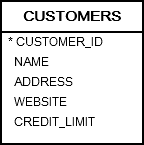Summary: In this tutorial, you will learn about PL/SQL cursor variables and how to manage cursor variables using REF CURSOR.
Introduction to PL/SQL cursor variables #
In PL/SQL, a REF CURSOR is short for reference cursor, which is a pointer to a query’s result.
A REF CURSOR allows to dynamimcally opens and fetches data from a query at runtime. Typically, you use the REF CURSOR to return query results from functions or stored procedures.
To declare a referencce cursor variable, you use the REF CURSOR as the data type.
PL/SQL supports two kinds of REF CURSOR types:
- Strong typed reference cursor ties to a specific query structure.
- Weak typed referencce cursor can point to any query.
For example, the following shows how to define a strong REF CURSOR:
DECLARE
TYPE customer_t IS REF CURSOR RETURN customers%ROWTYPE;
c_customer customer_t;Code language: PostgreSQL SQL dialect and PL/pgSQL (pgsql)This form of cursor variable is called strong typed REF CURSOR because the cursor variable is always associated with a specific record structure, which is customers in this ccase.
Note that we use the customers table from the sample database.
Here’s is an example of a weak typed REF CURSOR declaration that is not associated with any specific structure:
DECLARE
TYPE customer_t IS REF CURSOR;
c_customer customer_t;
Code language: PostgreSQL SQL dialect and PL/pgSQL (pgsql)Starting from Oracle 9i, you can use SYS_REFCURSOR, which is a predefined weak typed REF CURSOR, to declare a weak REF CURSOR as follows:
DECLARE
c_customer SYS_REFCURSOR;
Code language: PostgreSQL SQL dialect and PL/pgSQL (pgsql)PL/SQL cursor variable examples #
We’ll use the customers table from the sample database:

First, define a function that gets all direct reports of a manager based on the manager id from the employees table in the sample database.
CREATE OR REPLACE FUNCTION get_direct_reports(
in_manager_id IN employees.manager_id%TYPE)
RETURN SYS_REFCURSOR
AS
c_direct_reports SYS_REFCURSOR;
BEGIN
OPEN c_direct_reports FOR
SELECT
employee_id,
first_name,
last_name,
email
FROM
employees
WHERE
manager_id = in_manager_id
ORDER BY
first_name,
last_name;
RETURN c_direct_reports;
END;
Code language: PostgreSQL SQL dialect and PL/pgSQL (pgsql)The function returns a weak typed REF CURSOR variable.
Second, call the get_direct_reports() function and processes the cursor variable to display the manager’s direct reports with the id of 46 using an anonymous block:
DECLARE
c_direct_reports SYS_REFCURSOR;
l_employee_id employees.employee_id%TYPE;
l_first_name employees.first_name%TYPE;
l_last_name employees.last_name%TYPE;
l_email employees.email%TYPE;
BEGIN
-- get the ref cursor from function
c_direct_reports := get_direct_reports(46);
-- process each employee
LOOP
FETCH
c_direct_reports
INTO
l_employee_id,
l_first_name,
l_last_name,
l_email;
EXIT
WHEN c_direct_reports%notfound;
dbms_output.put_line(l_first_name || ' ' || l_last_name || ' - ' || l_email );
END LOOP;
-- close the cursor
CLOSE c_direct_reports;
END;
/Code language: PostgreSQL SQL dialect and PL/pgSQL (pgsql)Summary #
- Use reference cursors (
REF CURSOR) to return result sets from fuctions or stored procedures.